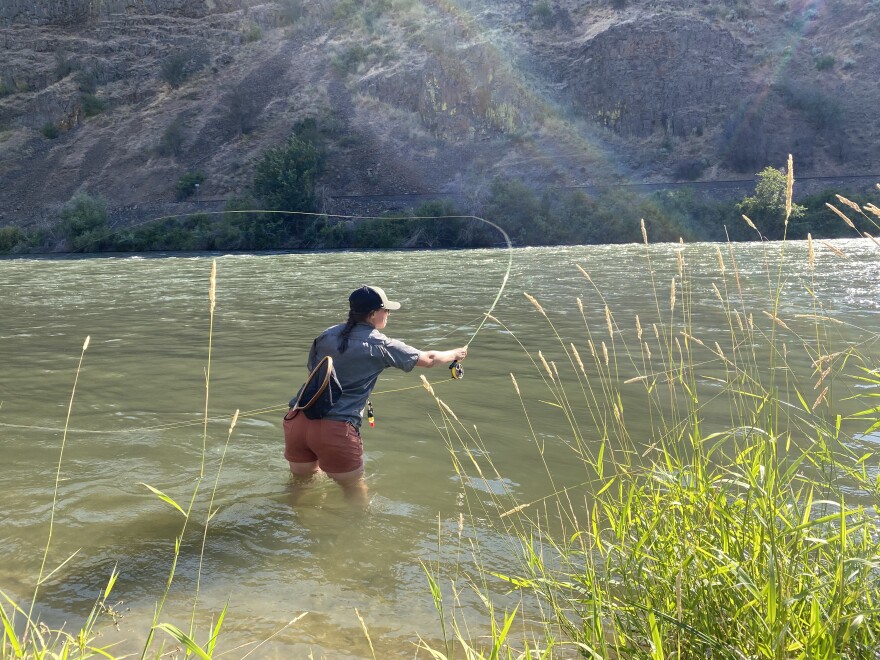Marsha Stipe lives near the Columbia River in Richland and pretty much every day she goes for a walk along the scenic path.
“Well, they’re quite annoying I’ll say that,” Stipe said.
She’s talking about caddisflies, and they’re nearly everywhere in the Columbia Basin. Tan-ish, small, like a very skinny housefly, with folded wings – the bugs have come out in hordes.
“They’re so thick, that walking along the river I wear a big hat. I wear sunglasses and actually just yesterday I was annoyed by them because when you go through the swarm of them it hits your arms and it feels like they’re biting you but I think it’s actually just that I'm invading their territory,” she said.
Stipe said the bugs tend to group-up along the path or above trees. As she walks along, she said it’s hard to avoid them.
“Eventually, one goes up your nose,” she said with a wry smile.

An aquatic canary
Recently in the Columbia Basin – east of the Cascades – piles of dead caddisfly bodies collect under streetlights but the insect is much more than a nuisance. The caddisfly – although not very showy or appreciated – is important for our environment, scientists say. The little insect starts its life in the rivers and streams of the Northwest and all over the world. It makes a little house for its body out of pebbles, sand and even twigs or pine needles. It binds that all together with its special sticky spit-silk.
Then it crawls around the bottom of the ponds, rivers and streams grazing on mostly scavenger foods: algae, plant materials, rotting leaves, little floaty things and dead organisms.
Some types of caddisflies are even predators. Different species can live in rivers and streams for a couple years. After they are grown, they crawl to the edge of the water.
“Then they pupate, so they form their cocoon. And then, out of that cocoon comes the adult caddisfly which most people think of look like dingy moths,” said Rich Zack, a professor of entomology with Washington State University.
He said then, when it’s ready, it and many of its friends of the same species emerge. In the adult stage, different species of caddisflies emerge all at once to increase their chances of overwhelming predators like fish and birds. They look for a mate. They swarm for love – and the love of porch lights.
“The adults usually don’t feed at all,” Zack said. “The female goes back to the water, lays her eggs and the cycle begins again.”
Because it lives so much of its life in the rivers and streams and because it is so sensitive to environmental factors – caddisflies are also a sort of canary for the health of our region’s rivers and streams.
“Generally, mayflies, stoneflies and caddisflies require cool clear water and pretty pristine conditions,” said Chad Larson, a scientist with the Washington State Department of Ecology. The caddisfly is so important that his agency and Oregon’s Department of Environmental Quality study the little guys regularly.
Both agencies survey the bugs in square-foot sections with nets. They also look for mayflies and stoneflies. Then, they compare that data year after year.
“Because they respond to flow, to pollution, to temperature and to all sorts of conditions – that’s why they make good indicators of water quality for streams and rivers,” he said.
The Environmental Protection Agency even looks at the health of macroinvertebrates across much of the nation. A macroinvertebrate means the little critters in the water you can see with your eyes.
Dry fly
Someone else who really appreciates the caddisfly? Ashtyn Harris of Ellensburg. She works in a busy fly fishing shop in a remote spot in the Yakima River Canyon.
“So we have a better-foam caddis, a parachute caddis, a para caddis, a hen wing caddis, elk caddis,” she said, naming off types of dry flies – nymphs are in a different section.
“Let’s see,” Harris said. “A missing link caddis, a rubber-legged caddis, the gunch and the emerger caddis.”
Turns out, dry-fly caddisflies are a prime lure for fishers. Outside, at her white 4x4 Toyota truck, she slips off her sandals and slides on some old tennis shoes. She then assembles her rod, strings the line. She then deftly ties an emerger caddis onto her line.
The river babbles at the shore and quaking aspen rattle just above. Tall grass sweeps in the wind.
Just steps from the shop, she wades in up to her thighs. Usually, Harris fishes by boat but she saw a flirty fish close to the shore, she explains. She works the line with her caddis fly for the silvery treasure.
Caddisflies emerging is a signal to Harris to put away her nymph lures that dive below and to pull out her dry flies that gently skim the surface.
“There’s nothing really special about them except it’s just the start of a new season in fly fishing,” Harris said.
Caddisflies. Not all bad.
Copyright 2023 Northwest News Network. To see more, visit Northwest News Network. 9(MDAyNTQ1NzQ1MDEyMjk0OTcxNTI4MzljZQ001))







